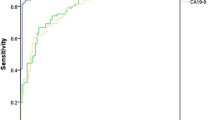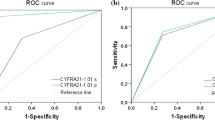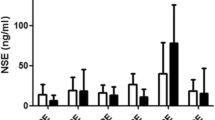Abstract
The classification of lung cancer into smallcell lung cancer (SCLC) and non-small-cell lung cancer (NSCLC) is essential for disease prognosis and treatment. For this purpose, we have tried to optimize the use of three tumour markers determined on pleural effusions, to differentiate SCLC from NSCLC by means of a canonic variable, generated by discriminant analysis, including subjects with histologically proven lung cancer. Discriminant analysis was performed by using carcinoembryonic antigen, neuron-specific enolase and tissue polypeptide antigen pleural levels, determined in 65 consecutive and unselected patients, histologically classified as 49 NSCLC and 16 SCLC. To validate the formula generated, a control group of 37 lung cancer patients (10 SCLC and 27 NSCLC), enrolled subsequently, was employed. Applying the discriminant analysis to SCLC and NSCLC patients a good classification was obtained (92% rate of correct classification). The aforementioned formula, applied to the validation group, showed a 92% rate of correct classification. This method, which is rapid, inexpensive and routinely applicable to malignant pleural effusions, may be reliably used to classify lung cancer patients.
Similar content being viewed by others
Abbreviations
- SCLC :
-
small-cell lung cancer
- NSCLC :
-
non-small-cell lung cancer
- CEA :
-
carcinoembryonic antigen
- NSE :
-
neuron-specific enolase
- TPA :
-
tissue polypeptide antigen
- CV :
-
canonic variable
References
Ameglio F, Abbolito MR, Giannarelli D, Citarda F, Grassi A, Gandolfo GM, Casale V (1991) Detection of Helicobacter pylori carries by discriminant analysis of urea and pH levels in gastric juices. J Clin Pathol 44:697–698
Ameglio F, Giannarelli D, Cordiali-Fei P, Pietravalle M, Alemanno L, Paone G, Amicosante M, Saltini C, Bisetti A (1994) Use of discriminant analysis to assess disease activity in pulmonary tuberculosis with a panel of specific and non-specific serum markers. Am J Clin Pathol 101:719–725
Cauberghs M, Clement J, Van de Voestijne KP (1993) Functional alterations accompanying a rapid decline in ventilatory function. Am Rev Respir Dis 147:179–184
Cooper E H. (1994) Neuron specific enolase. Int J Biol Markers 4:205–210
Drent M, Mulder PGH, Wagenaar Sj Sc, Hoogsteden HC, Velzen-Blad H van, Bosch JMM van den (1993) Differences in BAL fluid variables in interstitial lung diseases evaluated by discriminant analysis. Eur Respir J 6:803–810
Ihde DC, Minna JD (1991) Non-small cell lung cancer part I: biology, diagnosis and staging. Curr Probl Cancer 15:61–104
Johnson BE (1993) Management of small-cell lung cancer. Clin Chest Med 14:173–187
Karsell PR, McDougall JC (1993) Diagnostic tests for lung cancer. Mayo Clin Proc 68:288–296
Klockars M, Lindgren J, Pettersson T, Hellstrom M, Norhagen A (1980) Carcinoembryonic antigen in pleural effusions: a diagnostic and prognostic indicator. Eur J Cancer 16:1149–1152
Lachenbruch PA (1977) Some misuses of discriminant analysis. Methods Inf Med 16:255–258
Lachenbruch PA (1980) Application of discriminant analysis in epidemiology. Methods Inf Med 19:220–226
Matthay RA, Coppage L, Coralie S, Filderman AE (1990) State of the art in medicine. Malignancies metastatic to the pleura. Invest Radiol 25:601–619
McKenna JM, Chandrasekhar AJ, Henkin RE (1980) Diagnostic value of carcinoembryonic antigen in exudative pleural effusions. Chest 78:587–590
McSharry C, Anderson K, Speekenbrink A, Lewis C, Boyd G (1993) Discriminant analysis of symptom pattern and serum antibody titres in humidifier related disease. Thorax 48:496–500
Menard O, Dousset B, Jacob C, Martinet Y (1993) Improvement of the diagnosis of the cause of pleural effusion in patients with lung cancer by simultaneous quantification of carcinoembryonic antigen (CEA) and neuron-specific enolase (NSE) pleural levels. Eur J Cancer 29A:1806–1809
Niwa Y, Kishimoto H, Shimokata K (1985) Carcinomatous and tuberculous pleural effusions. Comparison of tumour markers. Chest 87:351–355
Overall JE, Kleitt JC (1978) Applied multivariate analysis. Chapter 14. Use of canonical variate for classification. McGraw Hill, New York
Petterson T, Klockars M, Froseth B (1988) Neuron-specific enolase in the diagnosis of small cell lung cancer with pleural effusion: a negative report. Eur Respir J 1:698–700
Pierucci G, Lucivero G, Amoroso C, Bonomo L (1984) Diagnostic value of carcinoembryonic (CEA) assay in pleural effusion. Tumori 70:16–18
Sahn SA (1993) Pleural effusion in lung cancer. Clin Chest Med 14:189–200
Sahn SA (1988a) State of art. The pleura. Am Rev Respir Dis 138:184–234
Sahn SA (1988b) Malignant pleural effusion. In: Fishman AP (ed) Pulmonary diseases and disorders, 2nd edn. McGraw-Hill, New York, pp 2159–2169
Sandler AB, Buzaid AC (1992) Lung cancer: a review of current therapeutic modalities. Lung 170:249–265
Shimokata K, Niwa Y, Yamamoto M, Sasou H, Morishita M (1989) Pleural fluid neuron-specific enolase. A useful diagnostic marker for small cell lung cancer pleurisy. Chest 95:602–603
Shinozaki T, Chigira M, Kato K (1992) Multivariate analysis of serum tumor markers for diagnosis of skeletal metastases. Cancer 69:108–112
Tamura S, Nishigaki T, Moriwaki Y, Fujioka H, Nakano T, Fujii J, Yamamoto T, Nabeshima K, Hada T, Higashino K (1988) Tumor markers in pleural effuision diagnosis. Cancer 61:298–302
Thompson EM, Proce AB, Altman DG, Sowter C, Slavin G (1985) Quantification in inflammatory bowel disease using computerised interactive image analysis. J Clin Pathol 38:631–638
Vladutiu AO, Wells Brason F, Adler RH (1981) Differential diagnosis of pleural effusions. Clinical usefulness of cell marker quantitation. Chest 79:297–301
Author information
Authors and Affiliations
Rights and permissions
About this article
Cite this article
Paone, G., De Angelis, G., Greco, S. et al. Carcinoembryonic antigen, tissue polypeptide antigen and neuron-specific enolase pleural levels used to classify small-cell and non-small-cell lung cancer patients by discriminant analysis. J Cancer Res Clin Oncol 122, 499–503 (1996). https://doi.org/10.1007/BF01187163
Received:
Accepted:
Issue Date:
DOI: https://doi.org/10.1007/BF01187163




